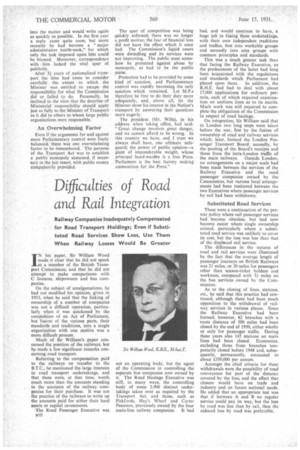Difficulties of Road and Rail Integration
Page 44

If you've noticed an error in this article please click here to report it so we can fix it.
Railway Companies Inadequately Compensated for Road Transport Holdings; Even if Substituted Road Services Show Loss, Use Them When Railway Losses Would Be Greater
IN his paper, Sir William Wood made it clear that he did not speak as a member of the British Transport Commission, and that he did not attempt to make comparisons with C licences, shipowners and bus companies.
On the subject of amalgamations, he had not modified his opinion, given in 1933, when he said that the linking of ownership of a number of companies was not a difficult operation, particularly when it was quickened by the compulsion of an Act of Parliament, but fusion of the various parts, their standards and traditions, into a single organization with one motive was a more difficult process.
Mlich of Sir William's paper concerned the position of the railways, but he made a few significant remarks concerning road transport.
Referring to the compensation paid to the railways on transfer to the B.T.C., he mentioned the large interests in road transport undertakings, and that these were, at that time, worth much more than the amounts standing in the accounts of the railway companies for their purchase. It was not the practice of the railways to write up the amounts paid for either their hard assets or capital investments.
The Road Passenger Executive was B10
not an operating body, but the agent of the Commission in controlling the separate bus companies now owned by it. The Road Haulage Executive was still, in many ways, the controlling body of some 2,900 distinct undertakings taken over as required by the Transport Act, and those, such as Pickfords, Hay's Wharf and Carter Paterson, previously owned by the four main-line railway companies. It had had, and would continue to have, a huge job in fining. these undertakings, with their own independent traditions and traffics, first into workable groups and secondly into area groups with common principles and standards.
This was a much greater task than that facing the Railway Executive, as the predecessors of the latter had long been acquainted with the regulations and standards which Parliament had placed upon them. In addition, the R.H.E. had had to deal with about 17,000 applications for ordinary permits, each of which required examination on uniform lines as to its merits. Much work was still required to complete the obligations of the Commission in respect of road haulage.
On integration, Sir William said that in London two long steps were taken before the war, first by the fusion of ownership of road and railway services which, later, formed the London Passenger Transport Board; secondly, by the pooling of the Board's receipts and those from the intra-London traffic of the main railways. Outside London, no arrangements on a major scale had been made between the services of the Railway Executive and the road passenger companies owned by the Commission, but various local arrangements had been instituted between the two Executives where passenger services by rail had been withdrawn.
Substituted Road Services
These were a continuation of the prewar policy where rail passenger services had become obsolete, but had now become easier where single ownership existed, particularly where a substituted road. service was unlikely to cover its cost, but the loss was less than that of the displaced rail service.
The differences in the natures of road and rail services were illustrated by the fact that the average length of passenger journeys on British Railways was 21 miles, or 30 miles for passengers other than season-ticket holders and workmen, compared with 3} miles on the bus services • owned by the Commission.
As to the closing of lines, stations, etc.. he said that this practice had continued, although there had been much opposition to the withdrawal of railway services in various places. Since the Railway Executive had been formed, however, 82 branches with a route distance of 500 miles had been closed by the end of 1950, either wholly or only for passenger traffic. During these years also 145 stations on main lines had been closed. Economies, excluding those from branches temporarily closed before 1948 and, subsequently, permanently, amounted to about £350,000 per annum.
Amongst the chief criteria for these withdrawals were the possibility of road conveyance for part of the distance covered by the line, and the effect that closure would have on trade and industry and on future national needs. He added that an appropriate test was that if between A and B no regular service could pay its way, but the loss by road was less than by rail, then the reduced loss by road was preferable.




























































































